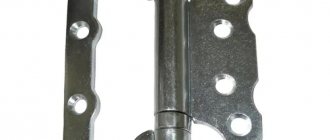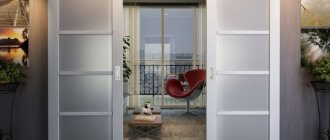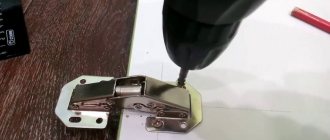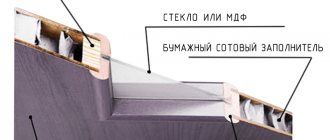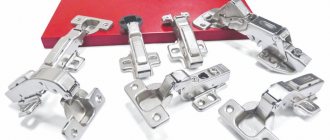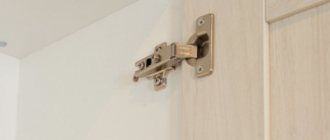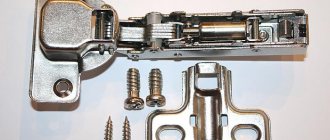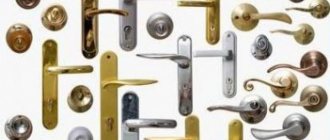This completes the installation. Periodically it will be necessary to check the operation of the hinges and adjust the compression, since the springs weaken during operation.
Installation diagram of spring hinges. 1) spring 2) hole in sleeve 3) stopper 4) screw 5) top nut
Adjusting the hinges must be done extremely carefully, otherwise you risk breaking the spring.
If you did everything correctly, the door will open freely and then attract itself to the frame. It may be necessary to add a couple of degrees of inclination to make the task easier.
We recommend watching the video:
- Instructions for installing double-sided spring hingesDownload 636.89 KB
DOORS - AUTOMATIC | MODEL CONSTRUCTION
There are so many devices that can be invented to make the front door close on its own. These include special spring loops, cargo devices with counterweights and a block system, and all kinds of springs or rubber strips. There are also those produced by industry, however, unfortunately, they are not without drawbacks: some are too complex and quite expensive, others are inconvenient to use or unreliable, and quickly fail. Therefore, home designers continue to solve these problems on their own, as evidenced by the proposed selection of materials sent by readers. In winter, the entrance doors of our houses are often left open. This leads to excessive consumption of energy required for heating staircases. To preserve precious heat, simple automation is needed.
However, you can do without mechanical devices by ensuring a slight tilt of the entire door frame. The main drawback - the door hitting the frame - can be easily eliminated by laying strips of thick rubber along the vertical part of the door frame.
Rice. 1. Spring door closing mechanism:
1 — rubber shock absorber, 2 — door, 3 — spring.
To ensure tight closure, use a device with a weight connected to the door using a cable passed through a block. Depending on the installation location of the latter, the returning moment will either increase or decrease. To limit the angular velocity of the door when closing, the load is placed in a vertical cylinder filled with some liquid, preferably mineral oil. Under the influence of weight, the load will fall in a viscous medium, which will limit its speed and, accordingly, the angular speed of the door. The gap between the pipe wall and the cylindrical surface of the load should be no more than 1 mm.
How to install butterfly hinges on doors yourself
For those who do not know how to embed hinges into an interior door, let us explain that this process consists of the following steps:
- applying special markings for hinges to the surface of the door leaf, as well as to the surface of the door frame;
- using a drill to drill holes for hinges in pre-marked places;
- checking the tightness of the door connection;
- checking the functionality of the door.
How to secure the door frame and install butterfly hinges on the interior door will directly determine their service life. The color range is not that wide. Most often there are imitations of various metals. In particular, copper, gold, bronze, or nickel. Butterfly door hinges can be either matte or glossy.
For those who do not know how to install hinges on an interior door, we provide detailed instructions.
Apply markings to the surface of the door leaf and the surface of the door frame;
- Install the rotary axis, which is the main structural element and which ensures the functioning of the entire mechanism.
- Measure 20 cm from the top and bottom edges of the door.
We make markings
- Place the loop at the mark.
- Attach the plates using self-tapping screws.
We attach the hinge to the box:
- insert the canvas into the box, in the same way mark with a marker the location of the other part of the loop on the outer border;
- place one part of the butterfly in place, circle the points for the holes with a marker;
- carefully drill holes, place the product in place and fasten it with screws;
- unscrew the loop from the end, then attach it to the outer area, use an awl to mark the locations for the holes;
- make holes and secure the hinges with self-tapping screws, first attaching the inner part of the hinge, and then attaching the outer side to the box.
This design is suitable for almost any type of door leaf, with the possible exception of heavy solid oak doors. Hinges for heavy doors are slightly different from ordinary ones; they have a thicker flange and have built-in bronze bushings.
For greater clarity, we recommend watching a selection of videos on installing butterfly hinges.
Solving possible installation problems
Since the ideal installation of this type of fastener is possible only with a perfectly flat door leaf (which is rare), some shortcomings may arise during the work: non-critical, but nevertheless requiring correction. We'll tell you how you can correct possible defects that appeared during the installation process.
It is important to correctly set the gap between the door and the frame
The most common problem when installing butterfly hinges is the gap between the hinge plate and the door frame. If there is such a defect, this means that the door will not be able to close tightly, which over time will lead to loosening of the structure and rubbing of the threshold. A small spacer made of cardboard, wood chips, or rubber band (even a match can do) solves this problem. The presence of such a gasket will slightly worsen the quality of installation, however, it will successfully solve the gap problem. If you are not satisfied with the fact that the butterfly hinge plates close too tightly, you can “drown” one part of the hinge a little into the thickness of the door frame.
Instructions. How to make a door closer with your own hands from various materials
A door closer is a very useful thing in everyday life. After installing it, using the doors in your house or apartment will become much more pleasant. In a hurry, did you not have time to close the door? The closer will do this for you - quietly, carefully, without annoying clap.
The door closer is quite easy to make and install with your own hands, you just need to be smart.
- A simple door closer option
- Door closer from car door lift
- Spring based door closer
- Door closer installation
A simple door closer option
To make your own door closer, you don’t need a lot of materials. First of all, before making a closer, you need to pay attention to its weight. To make the simplest design, you will need a weight.
The heavier and more massive the door in size, the heavier the closer should be. Those who are making such a useful household item as a door closer for the first time are advised to determine the weight of the load experimentally. There is no specific formula for calculating the mass of a load.
To make the simplest version of a door closer, you will need a rope or cable, as well as one more element - a wheel, which is necessary to move the rope up and down. The load is attached to the end of the rope or cable - it will pull the canvas.
To prevent the load from hitting the door leaf and wall, spoiling their appearance, it must be placed in a piece of plastic pipe. A weight is placed in the pipe and attached to a rope. Then they attach this structure to the canvas - and the simplest door closer is ready.
Door closer from car door lift
Is your car door broken? Don't rush to throw away the lift. Only three or five lifts from car doors will be needed to make a door closer.
The lifts must be attached to the canvas so that the closure bracket is located between the hinge axis.
This type of door closer is good because its manufacture does not require the purchase of any complex mechanisms.
Even if the doors are wide open, thanks to this closer they will close smoothly and softly.
Spring based door closer
With your own hands you can make another type of door closer for a wooden panel. The base of the design is a spring that gently returns the blade to its original position when opening and closing. Making such a door closer is quick and quite simple, but it is only suitable for light wooden panels, since with prolonged use the spring quickly becomes unusable.
The spring design of the closure can become stronger if it is complicated. But first, let’s figure out what elements are needed to install this structure on the door.
The basis of the closure is a spring. In addition, to slow down the movement of the door you will need a shock absorber.
The door closer shock absorber is designed on the principle of a conventional piston. The shock absorber consists of two chambers filled with oil. When the door is opened, one of them fills with oil. When the door is closed using this design, the oil flows into the second chamber.
There is nothing fundamentally new in the design of such a mechanism. Even a novice craftsman can make such a door closer; the main thing is to correctly manufacture the inside of the device. To allow the oil to flow back, a bypass valve is installed inside the structure. However, you can go the other way by installing an ordinary pump instead of an oil shock absorber.
It is not easy to adjust the pump to the operation of the door. Like a door closer made of a primitive weight and cable, such a door closer can only be adjusted to the functioning of the doors through trial and error.
To make such a structure, it is necessary to select a rack-and-pinion gear, the size of which depends on the size of the structure. It is through it that the load on the spring comes. The strength of the rack and pinion determines how long the door closer will serve you.
For those who do not want to use such complex devices, there is a simple alternative - use a piece of old rubber or a car inner tube as a door closer. Such a door closer can work quite reliably for some time, but it does not look very aesthetically pleasing.
Door closer installation
Installation of the door closer is a very important part of the work. Its functioning depends on how correctly the closer is installed.
So, installation of a closer includes the following actions:
- Determining the door opening angle;
- Using the template from the kit;
- Marking the holes on the frame and the door itself;
- Drilling pre-marked holes;
- Securing the lever with screws;
- Spring adjustment.
How to adjust a door closer
Silent, smooth opening and closing of doors is ensured by service mechanisms. Installed door closers affect the speed and fix the blades in the open position. Models with wind brakes are used at building entrances. The review contains recommendations on how to adjust the door closer and improve the condition and operation of the equipment.
Manufacturers produce two types of equipment:
- cam slide;
- gear lever.
Cam models are intended for lightweight structures only. The “cam” moves along the rollers and puts pressure on the working spring. The mechanism ensures smooth closing.
The most common option is gear lever mechanisms. Energy is transferred to the spring through gears. Such door closers are suitable for heavy doors with combination locks.
Depending on the placement there are:
- top (overhead);
- floor;
- hidden (frame) closers.
The upper models are installed above the sashes. Entrance and facade groups are equipped with models adapted for use in cold or hot climates. Inexpensive devices are equipped with a sliding rod or gear mechanism.
Floor-standing options are attached to the bottom of the door blocks. This is the best option for office, banking premises, shopping and entertainment complexes. The devices are almost invisible to visitors.
Floor structures are often installed under glass, intercom doors that open in both directions. Standard regulators are designed for sashes weighing up to 120 kg. An internal shock absorber prevents the door leaf from hitting the door frame. The shock-absorbing mechanism reduces loads and extends service life.
Hidden structures are placed inside the frame or in the floor. The minimum thickness of the door leaf for installation is 40 mm. Independent adjustment of the mechanisms is almost impossible due to difficult access. Such equipment is intended for premises with increased requirements for interior design.
The devices consist of a housing, a spring, a piston, adjusting screws, gears, bearings, rubber seals, and fasteners. Most models have a metal body. Decorative plastic trim is more often used on models intended for interior doors.
The operating temperature range is -40 – +50 degrees. Fire-resistant structures designed for fire-fighting equipment and bank vaults can withstand fire exposure up to +300 degrees.
The optimal model is selected according to the parameters of the door block. The weight of the sash and the width of the leaf are taken into account. Manufacturers produce various series for indoor and outdoor installation, sliding structures. The housings of outdoor models are protected from vandalism and the ingress of dust and dirt.
Based on maximum load, equipment is divided into several classes - from EN1 to EN7. The class is determined by the weight of the closer, the door leaf, and the width of the opening. EN1 devices are designed for a maximum weight of 20 kg, opening width up to 75 cm, EN7 - for 160 kg and 160 cm.
When choosing, the orientation is taken into account - left-handed or right-handed. The working life is designed for a certain number of opening-closing cycles. The color and design of the selected model must match the interior of the room.
The operating principle of the mechanisms can be:
- hydraulic;
- pneumatic;
- electric.
When the doors open, the spring is compressed and accumulates energy to return the door leaf to its original position. The pressure is exerted by the piston of the traction device. Racks and gears move the piston. The height of the gears is adjusted with screws.
During movement, the piston opens and closes holes for oil overflow. Oil flows through the valve system into the free part of the housing. The straightening spring provides a smooth return stroke. The spring transfers energy to the rod or rack. Thanks to the lever system, the structure returns to its original position.
The rod moves in the oil, pushing the liquid through the jets. The viscous environment prevents movement. The spring continues to act on the rod and the door begins to close. How to adjust the door closer? To change the speed of movement, the cross-section of the jets passing oil is optimized.
When tightening the screw with the oil seal, the gaps in the technological holes are blocked. The volume changes more slowly, the angular velocity of the valve decreases. At the end of the cylinder, the piston reaches a system of holes corresponding to the aftershock (finishing).
In most cases, setting up and adjusting the closer can be done with your own hands. The initial adjustment of the mechanism is performed immediately after installation. Preventative inspections and elimination of minor faults are carried out 2-3 times a year.
How to adjust the door closer? The condition of the lubricating fluid is affected by the state of the environment. Structural parts are subject to constant thermal expansion and contraction. In winter, the oil thickens and the door speed slows down. In summer, the structure heats up and the doors close very quickly. Therefore, the main procedures are carried out during the changing seasons.
Adjustments are made during scheduled maintenance. During the setup process, the optimal parameters are established. With constant temperature fluctuations, the closers are adjusted more often - once every three to four months.
Significant temperature fluctuations destroy the mechanism, causing breakdowns and damage. At the first sign of malfunction, the device is checked. Oil leaks are eliminated and worn parts are replaced.
Important! In case of complex malfunctions, knowing how the closer is adjusted will not help solve the problem. In such cases, the device is returned for repair or replaced with a new one.
The frequency of scheduled maintenance is influenced by the service life of the equipment (old equipment breaks down more often), frequency of use, and the average value of constant loads.
When opening the door, the mechanical energy of movement is transformed by the built-in drive. The reverse process consists of two phases:
Closing moves the door from any initial state to the “15 degree angle with the wall” position. The final finishing phase (finishing) ensures smooth movement of the blade in the cycle “from 15 to 0 degrees”.
The adjustment helps the door block close slowly and reduce the force of the slam.
The closers have two screws that regulate each phase. The screw marked “1” corresponds to closing, and the one marked “2” corresponds to finishing (latching). Some models are equipped with a third screw that regulates the opening and closing force.
The location of the controls and recommendations for handling are usually given in the operating instructions. Typically the screws are located under a protective cover on the front of the case or on the side.
The speed of movement of the sash is changed by tightening the screws. A screwdriver is required for adjustment. Before starting work, the canvas is opened completely and fixed.
How to loosen a door closer? Turning the screw counterclockwise slows down the blade. The clap should be slow so that the canvas does not break against the box.
Spring hinges: selection and installation
Spring hinges belong to the category of hidden double-sided awnings and have several names: bar, subway, western. Their distinctive feature is the ability to open the door in any direction, which is why they are also called pendulum. The scope of application of such loops is in places with high traffic: bars, shops, medical institutions, industrial and retail premises. The installation of these elements has some features, which you can learn about by reading this article.
Spring hinges are usually installed in high traffic areas
Types of door hinges
The first door hinges in human history were made from animal skin, tree branches tightly woven together, and only much later - from a rough metal plate. Today, door canopies perform not only a practical function, but also a decorative one, decorating the door and the interior as a whole. Types of canopies differ according to several criteria:
- the material from which they are made (steel, brass, bronze, etc.);
- installation method (overlay, screw-in, insertion);
- design features of the mechanism (overhead, mortise, hidden, corner, double-sided).
Let's look at the last classification in more detail:
- Invoices. Hinges of this type are the most popular, due to their ease of installation and low cost.
To install overhead hinges, it is enough to secure them with self-tapping screws on the surface of the door frame and the door itself.
- Mortise. The design of these hinges is almost identical to overhead hinges; the only difference is in the installation method: hinges of this type are cut into the surface of the door.
Installation of mortise hinges requires experience with a chisel
- Screw-in, hidden. These are not the most popular hinges, which is explained by the fact that they are quite difficult to install (inside the frame and door leaf), and after installation, the door leaf cannot be removed without completely dismantling the hinges.
If it becomes necessary to remove the door, you will first have to remove the hinges
- Angular. They differ from all others by the absence of classic cards. Instead, corners are fitted to the central hinge. The advantage of such hinges is the possibility of installing hinge doors on doors with a rebate.
The advantage of corner hinges is that they can be installed on rebated doors
- Double sided. Outwardly, these canopies are similar to ordinary card canopies, but they have their own fundamental differences.
Spring hinges differ from simple double-sided hinges by the presence of a spring
The secret to securely attaching hinges
There is such an important point when using hinges - this is the reliability of fastening the doors. Without reliable fastening, the smooth fastening system will be unnecessary.
Hinge Cup Attachment
You can secure the hinge cup to the door using self-tapping screws, but there is a more reliable method of fastening using special spacer plugs and screws.
To install the plugs, you need to drill two holes with a diameter of 8 mm. Find out if such a service is provided in the place where you order drilling for awnings.
| Rice. 27-28. Drilling the facade under the hinge cup and spacer plugs |
| Rice. 29. Spacer plugs for attaching the hinge cup |
| Rice. 30. Installation diagram for a hinge with Expando spacer plugs |
Mounting the strike plate
The strike plate can be secured to the side wall using self-tapping screws, Euroscrews, and the most reliable way is with Euroscrews of smaller diameter through spacer plugs.
The structure of the chipboard is loose and a self-tapping screw or Euroscrew may eventually break out of the chipboard and you won’t be able to screw it back in, you’ll have to glue in the chips, re-drill, and then, it won’t last long, you’ll have to change the side wall. Only a bar for spacer plugs will ensure long-lasting and reliable fastening.
Drilling is done with a drill with a diameter of 5 mm, similar to drilling for Euro screws.
Features of spring hinges
A double-sided spring hinge is fundamentally different from a classic card hinge and consists of two cards on pins, inside of which a spring is installed that returns the door leaves to their original position. Depending on the direction of opening of the door leaf, spring hinges can be: left-handed, right-handed or universal. Left-handed - opens only on the left side, right-handed - on the right, universal - in both directions. Bar canopies have their own characteristics, advantages and disadvantages.
Advantages
The main advantage of bar hinges is their ergonomics, as well as the high throughput of doors equipped with them. The double spring hinge has the following advantages:
- ease of opening the door (using the body) when your hands are busy;
- preventing heat loss in the room through the door;
- the possibility of unhindered passage of a large number of people;
- preventing the formation of drafts in the room;
- automatic door closing.
Flaws
Door spring hinges, well made and installed correctly, have only one drawback: cost. The price of such canopies is several times higher than the cost of classic card canopies.
Criterias of choice
Choosing spring hinges is no more difficult than regular ones: the main thing is to know what to pay attention to. The first and main criterion for choosing canopies does not imply aesthetic qualities or even the quality of the products.
Let's consider the selection algorithm step by step:
- The first thing you should decide on when purchasing hinges is the direction in which the door opens: hinges can be right-handed, left-handed, or universal.
- The second most important criterion is the width of the part. It should also be remembered that spring hinges are selected in accordance with the width of the door leaf.
- The third thing you should pay attention to is the load weight that the loop is designed for (from 25 to 60 kg per loop). Depending on the weight of the door leaf, you may need from 2 to 4 hinges.
- Fourth: aesthetic qualities. Products may vary in length and color. The most common sizes are: 75, 100 and 125 mm; colors: brass (matte and polished), chrome (matte and polished), bronze.
Models made in antique design
In addition, when choosing, you should pay attention to the following possible options:
- possibility of adjusting the door closing speed;
- the presence of bearings ensuring soft, smooth and quiet running.
It is worth paying attention to products from trusted brands
Product range overview
Boyard offers a wide selection of products, each of which undergoes quality control and technical tests for strength, durability, and functionality. These products for facades have different configurations and are made from a variety of materials - aluminum, glass, natural wood, wood chip fiber.
According to their design features, there are the following types of Boyard hinges.
- Mezzanine MK01 – modification for doors that open upwards. The product is equipped with a spring, so it is fixed in the open and closed position and can withstand loads of up to 2 kg.
- Hinges without a spring are mainly used if the facades are overhead, inset or semi-overlay, and the furniture does not have handles.
- Furniture products of a reinforced design with a return spring are ideally suited for heavy, large facades.
- Transformer hinges have an opening angle of 165 degrees, so the door can actually open 180 degrees.
- Boyard hinges of 30 and 45 degrees are suitable for corner (top) shelves of cabinets.
- Hinges with closers (hydraulic shock absorbers) are relevant for assembling kitchen furniture, inset and overhead types of doors. They are equipped with a mounting plate with 4 holes, which provides increased rigidity of fixation of the product.
- Also relevant are parts for hanging glass doors and for vertical opening. These models are suitable for assembling furniture for the kitchen, living room and other rooms. When manufacturing corner cabinet structures, a special, corner one-way hinge with a certain installation angle for the inner plane of the false panel can be used.
Installation of spring hinges
The installation of spring hinges is not much different from the installation of conventional hinges of the overhead and mortise types. The sequence of actions is as follows:
- At the end of the door, as well as on the door frame, marks are made about the location of each half of the hinge.
- After this, the stopper should be removed from both cards, this will release the spring.
- Next, insert a pin (mandrel) into the hole on the bushing and turn it clockwise.
- The hinge plates are applied to the base and fixed with self-tapping screws according to the diagram below.
Before installation, the spring loop relaxes, and after completion of work it contracts.
- After this, you need to compress the springs. To do this, the door is closed, the pin on each card is turned clockwise and the stopper is inserted.
- First of all, the springs are screwed to the door leaf, and then to the door frame.
Intermediate stage for installing bar hinges
- Upon completion of work, you should check the smooth movement of the door and, if necessary, adjust the spring.
- When tightening the loops, it is important not to overdo it, since the spring is very easy to break. At this point the installation can be considered complete.
Spring hinges are often installed in restaurants and bars
To clearly understand what spring hinges are, as well as the principle of their installation, it is recommended to watch the video.
How to install a spring on a door: process
Installing door springs is convenient because you can do it yourself, doing it correctly, without encountering difficulties, and having the opportunity to save financial costs.
When installing door springs for entrance doors, not including technical aspects, the following work should be done:
- At the beginning of work, you need to make marks on the box where the base of the door goes, as well as at its end, where in the future half of the installed hinge will be located.
- To release the spring, you need to decompress it.
- To release the spring, the process of removing the stopper from both cards will be required.
- Place the pin on the bushing and then turn it clockwise.
Portal about construction
01/18/2019 admin Comments No comments
To protect the door from premature failure, closers are often used. These devices are designed to smoothly and accurately slam the door leaf. A specific model is selected based on many factors:
- temperature changes;
- expected load;
- the weight of the canvas itself;
- required level of reliability.
Often such mechanisms cost a lot, and if for external doors this is justified by the reliable service of purchased devices, then for internal doors or a summer house it is more economical to make a homemade closer.
How does the closer work?
A standard door closer is divided into three components:
- main fastening body;
- barbell;
- fastening element.
There is a spring inside the device body, which compresses when the door is opened. As soon as the canvas is released, it will begin to return to its original state. A special composition helps slow down this process and make it smooth - due to its viscosity, it prevents the door from abruptly slamming.
One of the internal mechanism options
The case has two compartments, in one of which the composition remains as long as the door is closed. When the composition changes, the oil flows into the second compartment, where the spring movement is inhibited.
The spring is closely connected to the rod - a movable element of the mechanism that connects the main body and an additional one - attached to the wall or door (depending on the model).
Product range overview
Boyard offers a wide selection of products, each of which undergoes quality control and technical tests for strength, durability, and functionality. These products for facades have different configurations and are made from a variety of materials - aluminum, glass, natural wood, wood chip fiber.
According to their design features, there are the following types of Boyard hinges.
- Mezzanine MK01 – modification for doors that open upwards. The product is equipped with a spring, so it is fixed in the open and closed position and can withstand loads of up to 2 kg.
- Hinges without a spring are mainly used if the facades are overhead, inset or semi-overlay, and the furniture does not have handles.
- Furniture products of a reinforced design with a return spring are ideally suited for heavy, large facades.
- Transformer hinges have an opening angle of 165 degrees, so the door can actually open 180 degrees.
- Boyard hinges of 30 and 45 degrees are suitable for corner (top) shelves of cabinets.
- Hinges with closers (hydraulic shock absorbers) are relevant for assembling kitchen furniture, inset and overhead types of doors. They are equipped with a mounting plate with 4 holes, which provides increased rigidity of fixation of the product.
- Also relevant are parts for hanging glass doors and for vertical opening. These models are suitable for assembling furniture for the kitchen, living room and other rooms. When manufacturing corner cabinet structures, a special, corner one-way hinge with a certain installation angle for the inner plane of the false panel can be used.
What functions should the slamming mechanism perform?
Before you make an automatic door closer with your own hands, you need to have an idea of what it should ultimately provide. The main function is shock absorption - preventing the door leaf from hitting the frame. Along with this, the following functionality is highlighted:
- adjustment - the ability to set the closing speed;
- attraction - if the closure is not tight, the mechanism will close the door itself;
- fixation - the ability to fix the closer in one position.
The last point is not mandatory for factory models either, so in the homemade version, any suitable objects are used as a stopper.
Its closing mechanism must attract and smoothly close the door. For these purposes, ready-made parts from cars or improvised means are used.
What it is?
Furniture hinges are a device by which the doors of a door structure are fixed to the facade of a furniture block. Different types of hinges can perform a variety of functions - there are simple models, the tasks of which are reduced to maintaining swinging, and there are models with a closer, they are needed for smooth closing without a sharp knock. Nowadays, when installing doors, four-hinged products are most common. They are characterized by ease of installation, durability and practicality, and can serve for a long time even with intensive use.
The design of any loop requires the presence of a cup, a bar, and a shoulder. The hinge is attached directly to the sash with a cup, and with the help of a strip it is secured to the furniture frame. In most cases, self-tapping screws or self-tapping screws are used for installation. The shoulder is attached between the bar and the cup, and accordingly, takes on the role of a connecting link. All structural parts are connected using a four-joint mechanism.
Car door closers
The trunk of a car is an ideal example of using an automatic closer. Smooth opening, closing and shock absorption make this part a worthy alternative to factory models.
Fasteners are attached to the part. Depending on the design, these can be brackets of various types. With their help, the finished device is attached to the door and wall (or frame).
Springs from a car closer
The advantage of this method is the ability to fix the door leaf in the open position: other homemade closers acquire this function only with the help of additional devices.
You can get the part in your car, by asking friends or at the market. It is cheaper to buy a used working part than to purchase a factory model of the slamming mechanism.
Smooth closing of doors using shock absorbers or closers
Smooth closing can be achieved in less progressive ways - this is the use of shock absorption systems. The Blum company calls such systems BLUMOTION .
Shock absorber or closer, which is installed on the hinge arm
This system in the form of an overlay is installed directly on the hinge arm. There are limitations here, such overlays can only be installed on Blum hinges and the design of the hinge must allow this. This information can be obtained from the seller. Let’s say at the moment you don’t have money for hinges with a built-in closer, but you can initially buy simple Blum hinges, and then buy additional hinge closers .
| Rice. 15. Operating diagram of the hinge closer |
| Rice. 16. Hinge on which you can install a hinge closer |
| Rice. 17. Blum hinge closer |
Shock absorber or closer, which is installed at the handle
This is a more universal solution for shock absorption when closing doors, called door shock absorber . Such closers can be used for hinges that are not equipped with a shock absorption system.
| Rice. 18. Shock absorber for doors |
The shock absorber can be installed in the following positions, according to the diagram. Usually, installing one door closer is sufficient.
| Rice. 19. Possible locations for installing the closer at the end of the housing |
The closer itself can be installed directly into the end of the housing by pre-drilling a hole, or installed using a holder. There are two types of holder available – cross-shaped and straight.
| Rice. 20. Insertion of the closer into the body |
| Rice. 21-23. Installing a door closer using holders |
Such shock absorbers are produced not only by Blum, but, for example, by Salice. I also installed these shock absorbers, one per door.
| Rice. 24. Salice shock absorbers |
| Rice. 25. Salice shock absorbers installed using holders |
Rubber door closers
To make such a door closer with your own hands, the thrifty owner will not have to spend money. They can act as an attracting and shock-absorbing device;
- pieces of rubber;
- pears;
- hoses or tubes.
An example of pipes suitable for use
Located on the door leaf, these elements are easily deformed when the door is opened, but just as easily restore their shape, ensuring the door closes.
The advantage of this type is its cost, ease of installation, and the ability to regulate mechanical force. Rubber has different densities, which allows you to select the best options for a particular door. The only drawback is that it is not aesthetically pleasing, since a piece of rubber or a pear as a closer does not look very attractive. However, for storage rooms and other non-public premises this is the best option.
Springs as a slamming element
One of the simple and affordable ways is to install a spring as a closer. The advantages of this method include:
- ease of installation;
- availability;
- possibility of exposure regulation;
- relative aesthetics.
Springs have a number of characteristics, due to which the optimal option is selected. There is no clear formula for which spring to use for a door of a certain weight. Therefore, you will have to choose empirically.
Simple spring mechanism
Installation involves installing one end of the spring on the door leaf, and the other on the frame or wall.
Types of furniture hinges and their purpose
Furniture hinges are one of the most important elements of fittings, since the practicality and durability of furniture modules and their aesthetics largely depend on them
The selection of these products should be given special attention, since manufacturers produce different types of hinges and each model has its own purpose. In our review we will try to talk about the most common types of hinges, the features of their structure, purpose, and give advice on selection and installation
Using a weight as a slamming mechanism
This method is becoming one of the oldest and is rarely used today. With this method, a cable or rope is attached to the door leaf, the second end of which is passed through a wheel attached to the wall or frame. A weight is attached to the end, which closes the door. Its weight has to be selected manually, since there is no exact formula for calculating it.
The advantages of this method include its low cost, simplicity and efficiency. If necessary, you can even lock the door.
The obvious disadvantage is that while moving, the load swings and hits the door or frame. In order not to spoil the surface, it is placed in a pipe with the appropriate diameter. This approach will preserve the door and give the composition a more attractive and neat look.
Homemade or factory made?
Factory closers have an undeniable number of advantages:
- easy adjustment;
- aesthetics;
- increased reliability.
In fact, their only drawback is the price: it is unwise to spend a lot of money if you need to take care of closing the door leading to the cellar, pantry or garage. In such situations, homemade analogues come in handy. With proper installation and assembly, they regularly perform the functions of a door closer, and at the same time, the cost of creating such an analogue is often limited by the price of the part itself.
What is a door spring and what types are there?
There are several options for solving the problem of automatically closing doors. The simplest of these is to install a door spring. This is a very cheap device, easy to install and replace. It is a regular steel spring, which is attached to the door at one end and to the wall at the other. When the leaf is opened, the spring is stretched, which ensures its return to its original position. The closing force depends on the rigidity, length, number of turns, diameter and other characteristics. Springs are the most reliable and durable type of closing mechanism. It is not afraid of temperature changes, high humidity, mechanical stress and vibration.
In addition to the classic spring mechanism, there are several more modern solutions that provide automatic return of door structures:
1. Door closers. These devices are equipped with a spring mechanism, which is enclosed in a housing. The design also includes an oil or other type of shock absorber designed for smooth movement of the door leaf. It prevents the loud slamming and sudden closing of doors that is typical of a conventional spring. Some models of door closers allow you to adjust the maximum opening angle and closing speed of the door, and have the function of fixing the door leaf in the open position. Depending on the type of spring used, devices are divided into two types: gear-driven and sliding-rod. The first type has a simpler and more compact design. The second option is more cumbersome, but its level of reliability and durability is higher than that of a gear drive. Among the main disadvantages of door closers are the rather high cost and the need to strictly adhere to operating rules (for example, you cannot open the door too sharply or apply force when automatically closing the door).
2. Spring hinges for the door. Very compact and convenient devices. They are ordinary door hinges equipped with a small but quite powerful internal spring. Products come in both overhead and pin, corner, and hidden. A special type of spring hinges are double-sided, which are also sometimes called bar hinges. They ensure that the door swings open in both directions and returns to the neutral position. Such hinges can be installed on entrance doors in cafes, shops, public institutions, etc.
Intermediate step in the arrangement of bar elements
After the fastening is completed, you should check how smooth the movement is; if something is wrong, make adjustments.
When making adjustments, it is important not to overdo it in tightening, as the spring can be torn off. When this process is completed, the installation part can be considered complete.
The design of double-sided spring hinges can be seen in this video:
Voted over 273 times, average rating 4.6
Comments
Unfortunately, there are no comments or reviews yet, but you can leave your...
Add a comment Cancel reply
We recommend reading
Hinges, Fittings Basic functions and characteristics of swing door hinges Each of us can remember old films in which the hero of the film is ...
Hinges, Fittings How to choose hinges for a plastic door, their characteristics Hinges for doors are a piece of profile fittings that ...
Hinges, Accessories Varieties of forged hinges will allow you to make the right choice! The door can be decorated in different ways. Someone pays attention to the decor...
Hinges, Accessories How to cut hinges with a router and what devices are used? When installing new interior doors, many are faced with...
